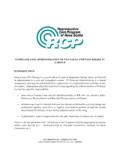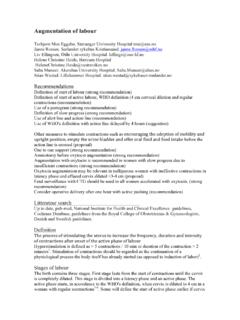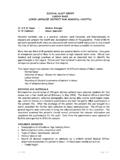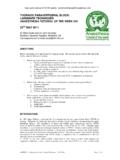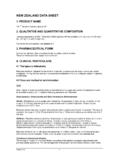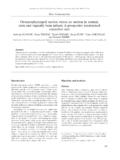Transcription of 120911 Nal CSL DS clean - Medsafe Home Page
1 DATA SHEET. NAME OF MEDICINE. naloxone Hydrochloride Injection MIN-I-JET. PRESENTATION. naloxone hydrochloride is 17-allyl-4,5 -epoxy-3,14-diphydroxymorphinan-6-one hydrochloride;. It is an off-white powder which is soluble in water. It is an opioid antagonist and is a synthetic congener of oxymorphone. naloxone Hydrochloride Injection is a clear, sterile, aqueous, colourless solution containing naloxone hydrochloride (as dihydrate) per mL. The solution also contains sodium chloride. USES. ACTIONS. naloxone is a competitive antagonist at opiate receptor sites. It can prevent or reverse the effects of opioids including respiratory depression, sedation and hypotension. It can also reverse the respiratory depression caused by pentazocine.
2 When naloxone is administered intravenously, the effects are usually apparent within 2 minutes; the onset of action is only slightly less rapid when it is administered intramuscularly or subcutaneously. The duration of action is dependent upon the dose and the route of administration but is usually in the region of 1 to 4 hours. Intramuscular injection provides a more prolonged effect than intravenous administration. Following parenteral administration, naloxone is rapidly distributed in the body. It is metabolised in the liver primarily by glucuronide conjugation and the metabolites are excreted in the urine. It is 50%. protein bound. The elimination half life in adults is 60-90 minutes and 180 minutes in neonates.
3 INDICATIONS. naloxone is indicated for the complete or partial reversal of narcotic depression, including respiratory depression, induced by natural and synthetic opioids such as codeine, diamorphine, methadone, morphine and propoxyphene. It is also indicated for the diagnosis of suspected acute opioid overdosage. DOSAGE AND ADMINISTRATION. naloxone hydrochloride may be administered intravenously, intramuscularly or subcutaneously. The most rapid onset of action is achieved with the intravenous route and is recommended in emergency situations. naloxone may be diluted for intravenous infusion by adding 2 mg naloxone hydrochloride to 500 mL of either normal saline or 5% dextrose. The resulting solution will contain 4mcg/mL of naloxone .
4 Infusion should be commenced as soon as practicable after preparation of the mixture in order to reduce microbial hazards. Preparations not used within 24 hours should be discarded. The rate of infusion should be titrated against the response of the patient. Do not use the solution if it contains particulate matter and/or is discoloured. Since the duration of action of some narcotics may exceed that of naloxone , the patient should be kept under continued surveillance and repeated doses of naloxone should be administered as necessary. naloxone 11th Sep 2012 1. Adults For the treatment of known opioid overdose, or as an aid in the diagnosis of suspected opioid overdose. Initial dose is mg intravenously given at 2 to 3 minute intervals if necessary.
5 If there is no response after a total dose of 10 mg has been given, the depressed condition may be due to a drug or disease process not responsive to naloxone . When the intravenous route cannot be used, the drug may be given by intramuscular or subcutaneous injection. For use postoperatively to reverse central depression caused by opioids used during surgery: The usual dose is to mg intravenously given at 2 to 3 minute intervals. The aim is to achieve an optimum respiratory response whilst maintaining adequate analgesia. Additional doses may be necessary at 1 to 2 hour intervals depending on the response of the patient and the dose and duration of action of the opioid administered. Supplemental intramuscular doses have been shown to produce a longer lasting effect.
6 Children The usual initial dose for children is 10 mcg/kg body weight ( mg/kg) given intravenously. If the dose does not result in adequate clinical improvement, a subsequent dose of 100 mcg/kg ( mg/kg). may be given. If the intravenous route is not available, naloxone may be given intramuscularly or subcutaneously in divided doses. If necessary, naloxone can be diluted with Water for Injections. Neonates For reversing opioid-induced depression in a neonate resulting from opioid dependence or analgesia given to the mother during labour: An injection of 10 mcg/kg ( mg/kg) may be given to the infant by the intramuscular, intravenous or subcutaneous route and repeated at intervals of 2 to 3 minutes if necessary.
7 Alternatively, for a more prolonged action, a single intramuscular dose of 60 mcg/kg ( mg/kg) may be given at birth. CONTRAINDICATIONS. Patients with known hypersensitivity to naloxone hydrochloride or to any ingredients in naloxone hydrochloride injection. WARNINGS AND PRECAUTIONS. Administer with caution to patients who have received large doses of opioids, or to those physically dependent on opioids, as a too rapid reversal may precipitate an acute withdrawal syndrome. When naloxone hydrochloride is used in the management of an acute opioid overdose, other standard resuscitative measures should be readily available (cardiopulmonary resuscitation and vasopressor agents). A withdrawal syndrome may also be precipitated in new-born infants of opioid dependent mothers.
8 The signs and symptoms of opioid withdrawal in a patient physically dependent on opioids may include, but are not limited to, the following: body aches, diarrhoea, tachycardia, fever, runny nose, sneezing, piloerection, sweating, yawning, nausea or vomiting, nervousness, restlessness or irritability, shivering or trembling, abdominal cramps, weakness, and increased blood pressure. In the neonate, opioid withdrawal may also include: convulsions, excessive crying, and hyperactive reflexes. Following the use of opioids during surgery, excessive doses of naloxone hydrochloride should be avoided as they may cause excitement, increase blood pressure and reverse analgesia. A too rapid reversal of opioid effects may cause nausea, vomiting, sweating or tachycardia.
9 naloxone 11th Sep 2012 2. Use with caution in patients (including the elderly) with pre-existing cardiovascular disease and in those receiving medications with potential adverse cardiovascular effects, such as hypotension, ventricular tachycardia, fibrillation, acute pulmonary oedema. Serious adverse cardiovascular effects such as ventricular tachycardia, fibrillation, acute pulmonary oedema, hypotension, hypertension and cardiac arrest have been reported. Death, coma and encephalopathy have been reported as sequelae of these events. It has been suggested that the pathogenesis of pulmonary oedema is, ie: a centrally mediated massive catecholamine response leading to a dramatic shift of blood volume into the pulmonary vascular bed resulting in increased hydrostatic pressures.
10 Patients who have responded to naloxone should be carefully monitored, as the duration of action of some opioids may be greater than that of naloxone . Renal Insufficiency/Failure: The safety and effectiveness of naloxone hydrochloride in patients with renal insufficiency/failure have not been established in well-controlled clinical trials. Caution should be exercised when naloxone hydrochloride is administered to this patient population. Liver Disease: The safety and effectiveness of naloxone hydrochloride in patients with liver disease have not been established in well-controlled trials. In one small study in patients with liver cirrhosis, plasma naloxone concentrations were approximately six times higher than in patients without liver disease.











